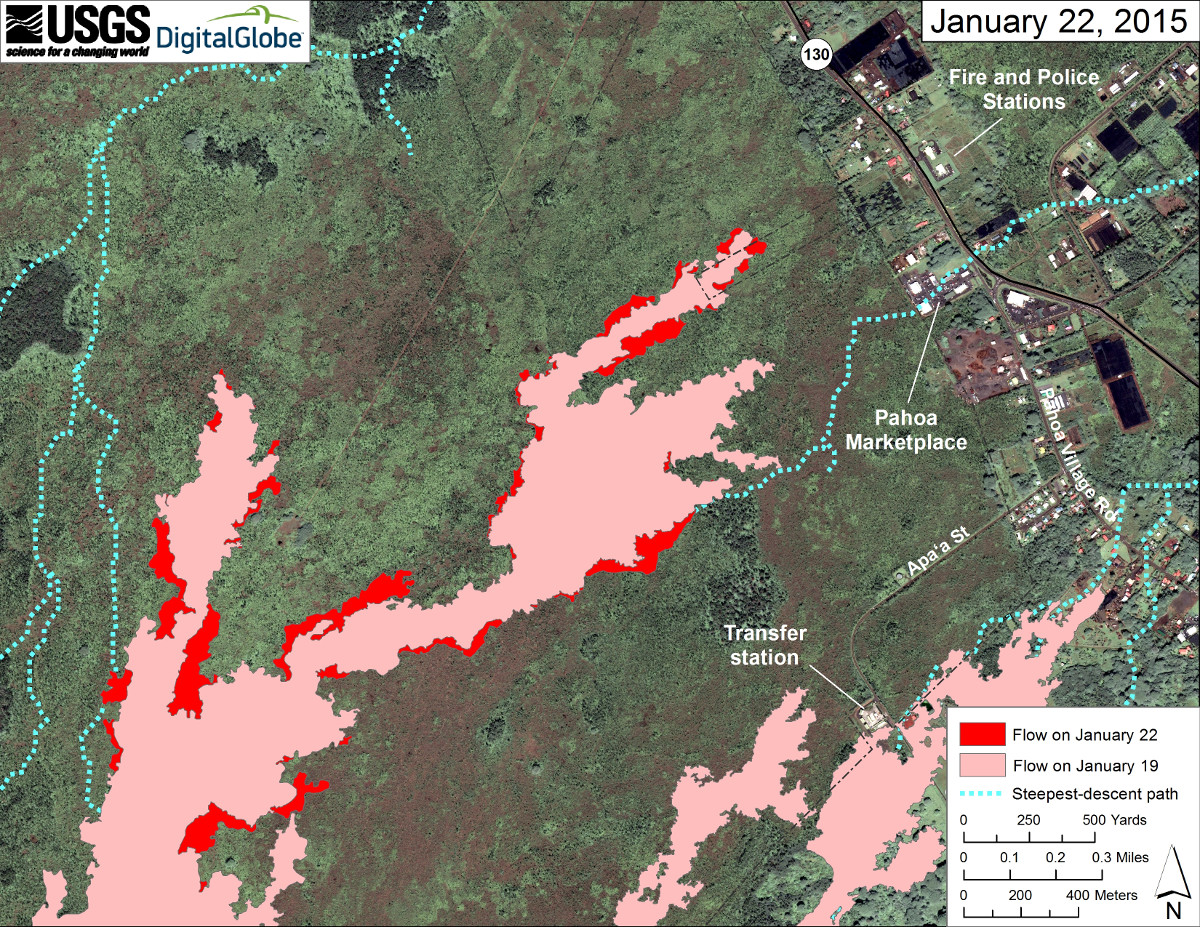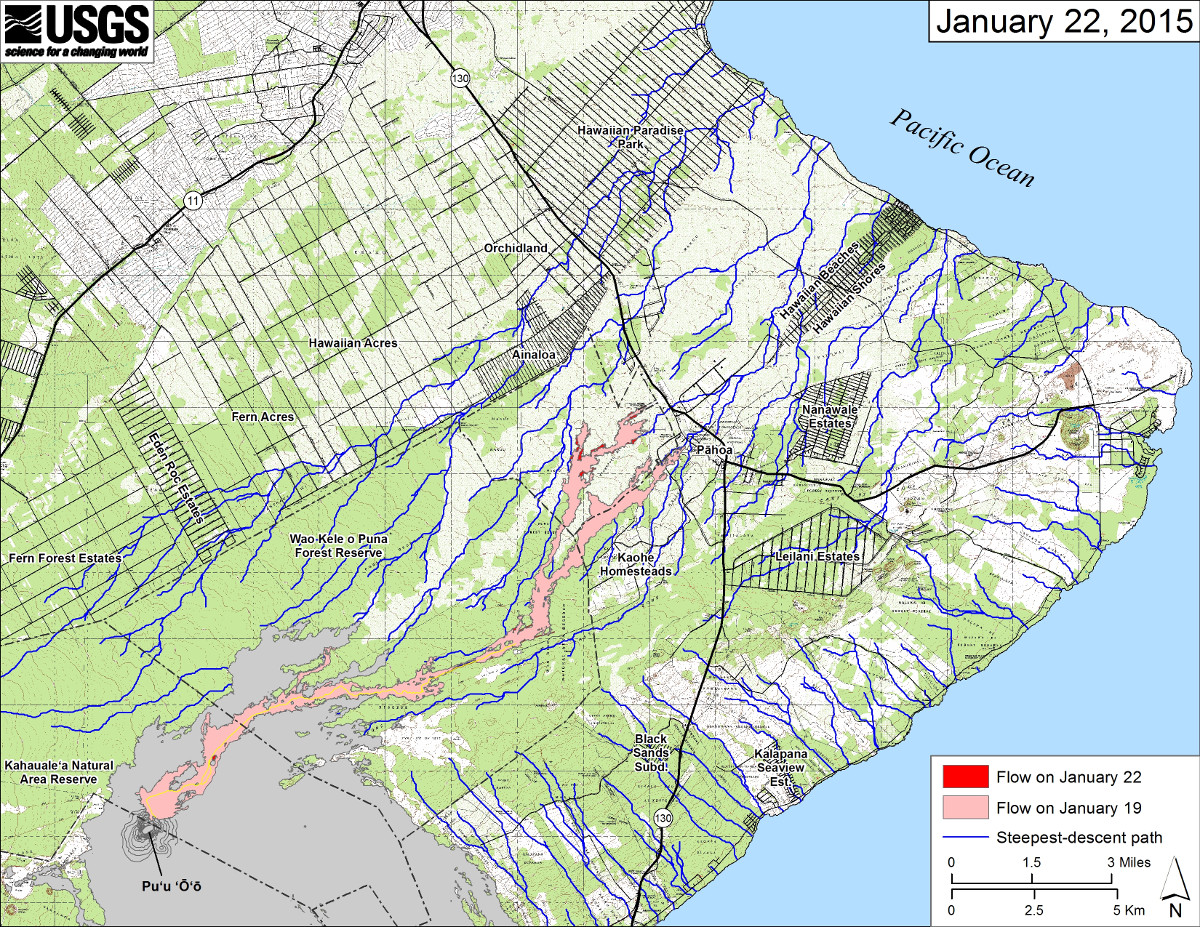(ABOVE) This Jan. 22 USGS Hawaiian Volcano Observatory photograph looks north, and shows the position of the leading tip of the flow relative to Highway 130. The brown swaths cut through the forest are fire breaks, and the large brown area at the left side of the image is a recent burn scar.
NEWS BRIEFS
- The breakout along the north side of the flow continues to be active and is widening, however it has shown little sign of advancement since Wednesday. During a community meeting Thursday night, USGS Hawaiian Volcano Observatory scientist Steve Brantley said they couldnt say for sure which path of steepest descent the lobe would take should it begin advancing again.
- Lava related brush fire activity is contained within the fire break perimeters and there is currently no fire threat to area residents and properties. Hawaii Fire Department chief Darren Rosario spoke to the community last night about the ongoing fire suppression effort, as well as plans to move out of the new fire station on Highway 130 should the lava lobe threaten the building in the future.
- Two active breakouts 1 to 1.5 miles upslope showed little activity and no signs of advancement. The lobe had entered a drainage area leading to the steepest-descent path that crosses Highway 130 about .6 miles south of the Makuʻu Farmer’s Market.
- There are breakouts along both margins of the flow and Civil Defense says all current activity does not pose an immediate threat to area communities. This activity was also detailed in last night’s USGS presentation.
- Smoke conditions were light to moderate with a light south wind blowing the smoke in a northeast direction.
LATEST MAPS

Jan 22 satellite image of area around front of Kīlauea’s East Rift Zone lava flow, courtesy USGS HVO

Small-scale map of Kīlauea’s East Rift Zone lava flow Jan. 22
PRIMARY SOURCES

This morning’s assessment shows that the original flow front and south margin breakout remain stalled. The breakout along the north side of the flow continues to be active and widening, however showing little signs of advancement since Wednesday. The leading edge or front of this breakout remains approximately 0.4 miles from the area of Highway 130 to the west or mauka of the Pahoa Police and Fire Stations. Two other breakouts along the north margin located 1-1.5 miles further upslope or behind the flow front showed little activity and no signs of advancement. A number of other breakouts along both margins of the flow and within the flow pad were observed however all current activity does not pose an immediate threat to area communities. The Hawaii County Civil Defense Agency and Hawaiian Volcano Observatory are maintaining close observations of the flow. Residents and businesses down slope will be informed of any changes in flow activity and advancement.
Hawaii Fire Department personnel and equipment remain on scene and are monitoring the fire conditions. All fires that occurred are contained with the fire break perimeters and all burning activity is limited to hot spots and flare ups within the fire perimeters. There is currently no fire threat to area residents and properties.
Smoke conditions were light to moderate with a light south wind blowing the smoke in a northeast direction. Smoke conditions may increase in some areas and individuals who may be sensitive or have respiratory problems are advised to take necessary precautions and to remain indoors.
On behalf of the Hawaii County Civil Defense Agency and our partners we would like to thank everyone for your assistance and cooperation. Hawaii County Civil Defense on Jan. 23 at 8 a.m. HST

Kīlauea Volcano continues to erupt at its summit and within its East Rift Zone. In the East Rift Zone, no significant advance of the lava flow leading edges was seen, but active breakouts persist upslope of the flow tips. From an HVO overflight, the leading tip of the lava flow was estimated at 585 m from Highway 130, but this was interpreted as not representing significant differences from County and HVO observations that have described the flow tip position as roughly 600 m (0.4 mi) from the highway. Breakouts were also active upslope and within the flow interiors. Along the flow margins, the breakouts are resulting in minor flow field widening.
At Kīlauea summit and Pu`u O`o, tilt measurements reflect minor inflation.
June 27th Lava Flow Observations: The distal reaches of the June 27th lava flow remain active, but the leading tip of the flow remains roughly 585 m, or roughly 600 m (0.4 mi), from Highway 130 without showing significant advance over the past few days. Scattered breakouts near and upslope of the leading tip, with a small active toe at the front and other breakouts extending from 85 m to ~3 km upslope. The north-northeast advancing lobe is also stalled for now, but this lobe is also producing scattered breakouts resulting in minor lateral expansion or widening of the flow margins. From yesterday’s HVO overflight, active breakouts were also noted in the area of the ground cracks and areas upslope.
Puʻu ʻŌʻō Observations: No significant changes are noted since yesterday in monitoring data streams from instruments deployed near Pu`u O`o. The Pu`u O`o tiltmeter shows minor inflation, and a few incandescent spots are visible in the Web cams. The most recent measurement of sulfur dioxide emissions from all East Rift Zone vents was about 200 tonnes per day on January 7.
Summit Observations: Minor summit inflation has continued since reaching pre-Jan 20 DI levels yesterday. Halema`uma`u Overlook lava lake levels continue to fluctuate and the lava lake continues to spatter. The lava-lake level has not changed significantly over the past several days, and yesterday morning the depth to the lava lake was measured at 45 m below the floor of Halemaʻumaʻu. Emission rate of sulfur dioxide ranged from around 4,500 to 7,600 tonnes/day during the week ending January 13.USGS Hawaiian Volcano Observatory on Jan. 23 at 9:03 a.m. HST

by Big Island Video News10:36 am
on at
STORY SUMMARY
The breakout along the north side of the flow continues to be active and is widening but has not advanced.